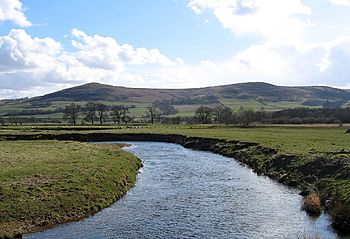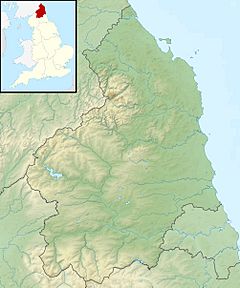River Glen, Northumberland facts for kids
Quick facts for kids River Glen |
|
|---|---|

River Glen
|
|
|
Location within Northumberland
|
|
| Country | United Kingdom |
| County | Northumberland |
| Physical characteristics | |
| Main source | 55°34′08″N 2°08′43″W / 55.5688°N 2.1454°W |
| River mouth | 55°35′11″N 2°02′20″W / 55.5865°N 2.0388°W |
| Length | 12 km (7.5 mi) |
The River Glen is a river in Northumberland, England. It is about 12 kilometers (7 miles) long. The River Glen is a branch, or tributary, of the River Till.
The river starts when two smaller streams, the College Burn and Bowmont Water, meet. These streams flow out of the Cheviot Hills. They join together near a village called Kirknewton.
As the River Glen flows, it passes by several small villages. These include Yeavering, Lanton, Coupland, Akeld, and Ewart. Finally, the River Glen joins the River Till.
Contents
Discovering the History of River Glen
The area around the River Glen has a very long and interesting history. People have lived here for thousands of years. You can find many old sites and artifacts.
Ancient Settlements and Royal Connections
On the hills south of the river, there are old forts from the Iron Age. These forts were built by early people living in Britain. They looked down on a special place called Yeavering.
Yeavering was once an important settlement and a palace site for the Angles, an early English people. A famous person named St. Paulinus visited Yeavering a long time ago. He was a Christian missionary.
According to an old book by a writer named Bede, St. Paulinus baptized many new Christians in the River Glen. He "washed them with the water of absolution in the river Glen, which is close by."
King Arthur and the River Glen
Some historians think the River Glen might be linked to the legendary British warrior, King Arthur. A very old Welsh book, Historia Brittonum, mentions a river with a similar name.
Because of this, some people believe that King Arthur might have started his battles against the Anglo-Saxons near where the River Glen meets the River Till. The book says:
- Then it was, that Arthur, with all the kings and military force of Britain, fought against the Saxons. And though there were many more noble than himself, yet he was twelve times chosen their commander, and was as often conqueror. The first battle in which he was engaged, was at the mouth of the river Glein.
Battles and Border Conflicts
The area around the River Glen was a place of many fierce battles. These fights happened between Scotland and England because the river is close to the border.
One important battle was the Battle of Humbleton Hill. It was fought near the river in the year 1402. Another battle, the Battle of Geteryne (also known as Yeavering), took place here in 1415.
Understanding the River's Flow
Scientists study how much water flows in rivers. This is called hydrology. The flow of the River Glen has been measured for many years.
Between 1966 and 2010, the river's flow was measured near Kirknewton. This was done at a special structure called a weir. The area of land that drains into the river at this point is about 200 square kilometers.
Over 44 years, the average flow of the River Glen was about 2.93 cubic meters of water per second. This information helps us understand the river's health and how it changes over time.
Images for kids



